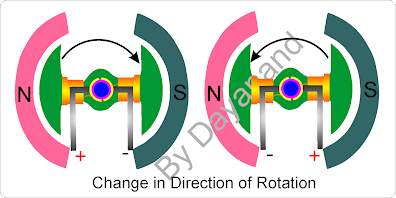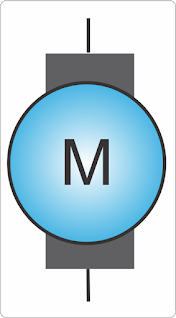 |
Let us discuss about DC motors which are the
most integral part of any moving machine starting from toys to robotic models.
This topic may extend to more than one post as there are different types of
motors which we will like to understand as they have different usage.
 |
It’s has been observed that electric current and magnetic field interact with each other and this dependency gives us an opportunity use them in electric motors and electric generators. As we saw in basic science chapter, that a current carrying conductor when comes under magnetic field, it experiences a force on itself till there is electric current in the wire. The force vanishes if the follow of electric current is stopped in wire. This phenomenon can be rightly denoted by Fleming's Left hand Rule. To understand the rule, stretch your left hand thumb, index finger and middle finger in such a way that all three are perpendicular to each other. If the index finger indicates the direction of magnetic field (from North to South pole) and the middle finger indicates the direction of current in the wire, then the direction of your thumb indicates the direction of force exerted on the wire. This is has been shown in picture here.
 |
It has been observed that the
magnitude of force is maximum if the direction of flow of current is perpendicular to the direction of magnetic field. Using this theory, let us see
how a current carrying coil kept inside a magnetic field feels force and then
rotate the shaft of motor. Refer the diagram where we have a magnetic field
present due to a permanent magnet with North pole at left and South pole at
right. So the direction of magnetic lines of forces is from left to right. We have
placed a rectangular coil of insulated copper wire in middle attached to shaft
of motor which blue in color. We have supplied current in the coil with the
help of a cell and the direction of current is shown with red arrows. Now stretch
your left hand fingers as suggested in Fleming's Left Hand rule above. Align
your index finger from your left to right and middle finger towards yourself. In
this condition your thumb will automatically point upwards. So this position
aligns with the left side of the rectangular coil, hence the force direction is
shown upwards in the picture.
Now for the right side of the
coil, align your left hand fingers so that your index finger still point from
your left to right. Middle finger now points away from you as the direction of
current in right side of coil is away from you. Now observe that your thumb
indicates downwards, hence the force on right hand side of coil has been shown
in downward direction.
So these two forces, upward on
left side and downward on right side of coil forces the coil to rotate in
clockwise direction. After half rotation is completed, again the coils reach on
same position and similar action happens, this keeps the coil to rotate till
the current is supplied from outside. And since the coil is attached with motor
shaft, the shaft also rotates along with coil.
You must be wondering that if the
coil is rotating, the wire through which we are supplying current will get
twisted. Your worry is correct; to avoid this, actual construction of motor
uses cylindrical contacts and carbon or metal brushes to supply current. The cylindrical
contacts are connected to coil and attached to motor shaft to rotate with it
and the brushes are stationary to supply current from outside as shown here.
The picture shows here the construction of a motor from inside. Permanent
magnets in pink and blue color are fixed. The shaft (in blue) contains a soft
iron core (in green) on which we have coil of insulated copper wire in Orange. There
is a small cylindrical insulating material attached to shaft shown in pink
color contains two semicircular metallic contacts shown on yellow color. These
semicircular contacts do not touch each other and are connected to the both
ends of coil. Two fixed carbon or metal brushes are in contact with these
semicircular contacts and the external supply is given through these fixed
brushes. Now the semicircular contacts, circular insulator and soft iron core
with coil rotates and keep getting current through brushes which are just touching
the semicircular contacts. This is how a DC motor is constructed.
 |
 |
Using this Fleming's Left Hand rule, we have observed one point that if direction of current is changed, the direction of force on conductor also changes. This property helps us to change the direction of rotation of motor by changing the direction of supply to a DC motor. So if we reverse the DC supply i.e. if we interchange the positive and negative terminal of cell, motor shaft will rotate in opposite direction. But for changing direction of AC motor we have different method, not as simple as this.
 |
| DC Motor Symbol |
There is one more property which
effect the magnitude of force applied on coil of motor or current carrying conductor
in magnetic field. Force on wire is directly proportional to strength of
magnetic field and strength of current flowing through wire. Since we use
permanent magnet in DC motor, hence we don’t have option to increase or
decrease the magnetic field strength. So, we can change the supply current to
change the magnitude of force on current carrying wire of coil of motor. The more
the force applied on coil, the more is the speed at which the shaft rotates and
vice-e-verse. So, by controlling current
through motor coil we can control its speed of rotation.
The speed of motor is measured in
RPM (revolution per minute). We have few basic specifications of a motor i.e.
operating speed i.e. RPM, voltage at which it should be operated. Maximum
current that it will draw when operated at rated voltage. Last one is amount of
torque it creates when operated at rated voltage and current. Torque is a twisting force
created by any rotating object or applied on any object externally. We will
discuss more in next topic where we will learn about geared motors.
That’s all about basic of DC
motor. Since this topic has already become big, we will learn about some types
of motors in next topic, which we use in electronic appliances or projects. Keep
watching and share your feedback. You may also subscribe through email so that
you get email alert when a new article is posted.








1 Comments
Thanks for the nice blog. It was very useful for me. I'm happy I found this blog. Thank you for sharing with us, I too always learn something new from your post.
ReplyDeleteMachinery Transport